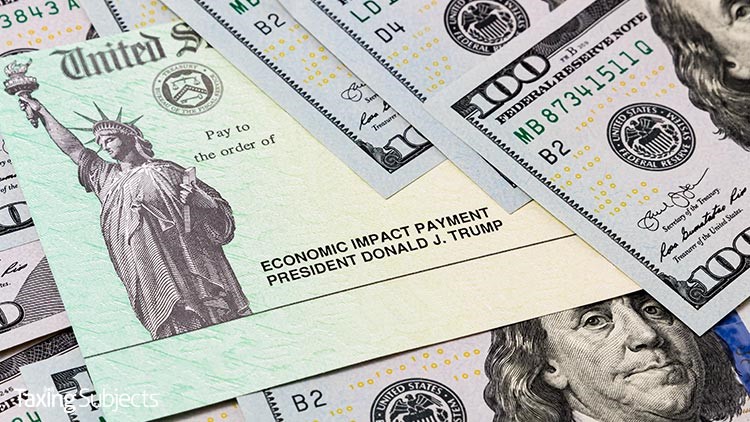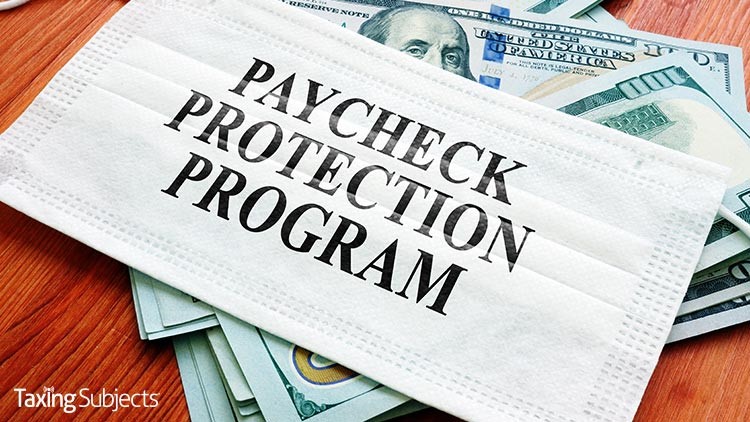by | Jan 12, 2021 | Tax Tips and News
It’s a busy time for the Treasury Department and the Internal Revenue Service.
They’re sending out some 8 million second-round Economic Impact Payments (EIPs) by prepaid debit card. The debit cards follow millions of EIPs already made by direct deposit and the ongoing mailing of paper checks to deliver the second batch of EIPs as quickly as possible.
Go online to check your payment status
Go online to the IRS website and bring up Get My Payment; if it shows a date that your payment was mailed, you can expect either a paper check or a debit card to arrive by mail.
An IRS release cautions taxpayers, however, that they should not be alarmed if there’s a glitch on the Get My Payment tool:
“For those taxpayers who checked Get My Payment and received a response indicating a direct deposit was to be sent to an account they do not recognize, the IRS advises them to continue to monitor their bank accounts for deposits.
“The IRS emphasizes that the information taxpayers see in the Get My Payment tool, including account numbers and potential deposit dates, may not display an accurate account number as we continue to work through updates. No action is necessary for taxpayers as this work continues; they do not need to call the IRS, their tax provider or their financial institution,” the release continues.
To speed up delivery, the Treasury Department’s Bureau of Fiscal Service is sending payments out by prepaid debit card.
The IRS and the Treasury are urging eligible people who do not get a direct deposit to watch their mail carefully during this time.
The prepaid debit card—called the Economic Impact Payment card—is sponsored by the Bureau of the Fiscal Service and is issued by MetaBank, N.A, the Treasury’s financial agent.
The Treasury does not determine who receives a prepaid debit card.
Taxpayers should keep in mind that the form of payment for this second round of Economic Impact Payments may be different than the first payment. Some people who got a paper check last time might get a prepaid debit card this time around, while some who received a prepaid debit card last time could get a paper check this time.
Moe information about these cards is available at EIPcard.com.
EIP cards are safe and secure
Taxpayers can trust that EIP Cards are safe, secure and convenient. Card recipients can make purchases online or in stores anywhere Visa Debit Cards are accepted. They can get cash from domestic in-network ATMs, transfer funds to a personal bank account – even obtain a replacement EIP card if needed without being charged any fees.
EIP Cards provide consumer protections, including measures guarding against fraud, loss, and other errors.
EIP Cards are being sent in white envelopes that prominently display the seal of the U.S. Department of the Treasury. The EIP Card has the Visa name on the front of the card and the issuing bank name (MetaBank, N.A) on the back of the card.
Each mailing includes instructions on how to securely activate and use the EIP Card.
Cards are being issued to eligible recipients across all 50 states and the District of Columbia. The IRS says residents of the western part of the U.S. are more likely to get an EIP Card.
This second round of payments comes after the successful delivery of more than $270 billion in CARES Act Economic Impact Payments in the first round.
To check the status of a payment, visit IRS.gov/getmypayment.
For more information about Economic Impact Payments, visit IRS.gov/eip.
– Story provided by TaxingSubjects.com
by | Jan 9, 2021 | Tax Tips and News
The Internal Revenue Service this afternoon announced it was working with the tax and financial industry to redirect Economic Impact Payments that were direct deposited in closed, inactive, or “unfamiliar” bank accounts.
“Some recipients may have had their payment directed to the temporary bank account established when their 2019 tax return was filed,” the IRS explains. “The IRS and tax industry partners are taking immediate steps to redirect stimulus payments to the correct account for those affected. The IRS anticipates many additional taxpayers will receive payments following this effort.”
The trouble seems to stem from two things:
- The short window for issuing payments prior to the beginning of filing season
- Federal law governing how banks handle payments sent to inactive accounts
Since Economic Impact Payments are actually an advance of the Recovery Rebate Credit (RRC) and federal law normally requires financial institutions to return money deposited in closed or inactive accounts, it initially appeared that those affected would need to claim the RRC on a tax year 2020 return to receive the stimulus money. Fortunately, it appears many of these payments will be successfully redirected.
Get My Payment, Mailed EIPs, and the Recovery Rebate Credit
The IRS release also contains additional information about direct deposits, mailed Economic Impact Payments, and the Recovery Rebate Credit:
- Direct deposits. For those who have not yet received direct deposits, they should continue to watch their bank accounts for a deposit in coming days. IRS tax industry partners are taking steps to redirect stimulus payments to the correct taxpayer account for as many people as possible. The IRS emphasizes that the information taxpayers see in the Get My Payment tool, including account numbers and potential deposit dates, may continue to display unfamiliar account numbers as the IRS continues to work through and update this issue. No action is necessary for taxpayers as this work continues; they do not need to call the IRS, their tax provider or their financial institution.
- Mail. Some people will receive their second Economic Impact Payment by mail, either as a paper check or in the form of a debit card. For people in this group, the IRS urges people to carefully watch their mail for either of these during January. Additional information is available on IRS.gov.
- Tax returns. While the IRS continues to closely work with our industry partners to quickly deliver more Economic Impact Payments, the IRS reminds eligible taxpayers who don’t receive a payment – or the full amount– that they can claim the Recovery Rebate Credit when they file their 2020 tax return. Taxpayers in this situation are urged to file electronically with direct deposit to ensure their tax refund – and their stimulus payment – reach them as soon as possible.
Finally, the IRS says that incorrect or unfamiliar information in Get My Payment does not mean your EIP was sent to someone else or stolen. “If you do not recognize the account number, it may be an issue related to how information is displayed in the tool tied to temporary accounts used for refund loans/banking products,” the release reads. “The IRS is working to address this. People do not need to complete Form 14039, Identity Theft Affidavit, or contact the IRS.”
Source: “IRS Statement — Update on Economic Impact Payments”
– Story provided by TaxingSubjects.com
by | Jan 8, 2021 | Tax Tips and News
The Internal Revenue Service has eased the cost of participation in the Paycheck Protection Program (PPP) by allowing deductions for the payment of eligible expenses.
The deductions are outlined in guidance issued by the IRS, and are allowed when such payments would result—or be expected to result—in the forgiveness of a covered loan under the Paycheck Protection Program.
The guidance, contained in Revenue Ruling 2021-02, reflects recent changes to law contained in the Tax Relief Act of 2020. This legislation was part of the Consolidated Appropriations Act, 2021 (Act), Public Law 116-260, which was signed into law on Dec. 27, 2020.
The Tax Relief Act of 2020 amended the Coronavirus Aid, Relief, and Economic Security Act (CARES Act) to say that no deduction is denied, no tax attribute is reduced, and no basis increase is denied by reason of the exclusion from gross income of the forgiveness of an eligible recipient’s covered loan.
The change applies for taxable years ending after March 27, 2020.
Revenue Ruling 2021-02 now makes both Notice 2020-32 and Revenue Ruling 2020-27 obsolete.
The outdated guidance disallowed deductions for the payment of eligible expenses when the payment resulted—or could be expected to result—in forgiveness of a covered loan.
For more information about this new guidance, the COVID-related Tax Relief Act of 2020 and other tax changes, visit the IRS website at IRS.gov.
– Story provided by TaxingSubjects.com
by | Jan 7, 2021 | Tax Tips and News
The Internal Revenue Service is reminding tax professionals and taxpayers that employers need to file Form W-2 and other wage statements by Feb. 1, 2021.
The February deadline is also the date employers must get wage statements to their employees.
The timetable is set by law
Employers are required by law to file copies of their Form W-2, Wage and Tax Statement, and Form W-3, Transmittal of Wage and Tax Statements, with the Social Security Administration by Jan. 31.
However, since Jan. 31 falls on a Sunday in 2021, the deadline this year is the next business day, which happens to be Monday, Feb. 1.
Other forms are due on the Feb. 1 date as well. Form 1099-MISC, Miscellaneous Income, and Form 1099-NEC, Non-employee Compensation, are also due to recipients by the Feb.1 date – with some exceptions.
For other due dates that are related to Form 1099, check out the form’s instructions.
Filing fights fraud
Employers who file their wage statements on time help not only themselves, but the IRS as well. The employer avoids late-filing penalties, and the IRS has time to verify the income taxpayers report on their tax returns, which helps prevent fraud.
As far as filing is concerned, e-filing is the most accurate and convenient way to send the forms to the IRS – by far. In fact, those employers who file 250 or more such information returns in a single calendar year must transmit their filings electronically.
Plan and prepare early
Good preparation now can help employers avoid problems later. For instance, employers can start by verifying or updating employee information, such as:
- Names
- Addresses
- Social Security Numbers
- Individual Taxpayer Identification Numbers
Employers should be sure their account information is current and active with the Social Security Administration as soon as possible. Lastly, employers should order paper Form W-2s, if needed.
It should be noted that are no automatic extensions of time to file Forms W-2. The IRS will only grant extensions for very specific reasons.
Employers should read the instructions for Form 8809, Application for Extension of Time to File Information Returns, for more information.
Source: Tax Tip 2021-01
– Story provided by TaxingSubjects.com
by | Jan 7, 2021 | Tax Tips and News
Ask most people what they thought of 2020, and the response is likely to be something like, “disastrous,” “catastrophic” — even “unprecedented.”
Ask IRS Commissioner Chuck Rettig, though, and he might say 2020 was his agency’s finest hour.
The just-departed year, while marked with turmoil and a pandemic, showcased the IRS’ ability to carry out a mission, no matter what the circumstances.
Annual report released
The IRS has released its annual report for 2020, which spotlights its work delivering taxpayer service and continuing compliance efforts in a year that saw the COVID-19 coronavirus challenge all aspects of the agency’s mission.
“Internal Revenue Service Progress Update/Fiscal Year 2020 – Putting Taxpayers First” outlines how the agency overcame difficulties during the pandemic to deliver Economic Impact Payments in record time. At the same time, IRS employees made adjustments to complete a successful filing season despite office closures and the latest tax deadline ever.
“The COVID-19 pandemic presented some of the greatest challenges to the IRS in its history, both in terms of being able to carry out our mission and in protecting the health and safety of taxpayers and our own workforce,” Commissioner Rettig wrote in the report’s opening message and addressed in his ‘A Closer Look’ column. “IRS employees responded admirably by quickly facilitating financial assistance to millions of deserving and needy Americans.”
But the 44-page report isn’t just about the pandemic and overcoming its challenges. It also documents the agency’s progress toward six strategic goals and documents the ongoing effort to modernize the American tax system.
In addition, the 2020 report shows work completed on implementing the Taxpayer First Act.
“Even with all the challenges, we believe we have made great strides during Fiscal Year 2020, but we want to do more,” Rettig said.
Rettig explained that each year the IRS collects more than $3 trillion in taxes and generates approximately 96% of the funding that supports the federal government’s operations.
“My experiences as Commissioner have strengthened my belief that a fully functioning IRS is critical to the success of our nation,” he said. “When citizens can perform their civic duty each year by preparing and filing their taxes and paying only what they should, they help fund critical aspects of the United States ranging from schools and roads to Social Security payments and the nation’s military.”
Service came first
The 2020 Annual Report lays out numerous examples of how IRS employees helped taxpayers during a very challenging year:
- Expanded information and assistance available to taxpayers in additional languages and underserved communities to help deliver Economic Impact Payments and other services.
- Adjusted agency processes through the People First Initiative to help people and businesses encountering payment and other challenges during the pandemic.
- Offered an electronic filing option for amended tax returns with the new Form 1040-X, marking a major milestone to help taxpayers and the tax community.
- Served their communities outside official duties through charitable donations and service projects.
The report also illustrates ways IRS employees worked to maintain the tax system through a strong, visible and robust tax enforcement presence. It says the agency enhanced its criminal investigation and civil enforcement efforts with an expanded use of data analysis and artificial intelligence across all lanes, from selection to examination.
In the Progress Update section, the report touts the IRS’ work partnering on landmark criminal investigations that brought down child pornography, drug and terrorist organizations.
The IRS, the report explains, continues to increase its pursuit of those who promote and use abusive tax shelters – including syndicated conservation easements. The agency has seen successful Tax Court results on these cases, as well as completion of its first settlement initiative.
The report also details the IRS’ Integrated Business Modernization Plan, which is a roadmap that guides the agency move to offer best-in-class customer service. This level of service is what people are accustomed to have when dealing with an online retailer or financial institution.
“As we move into the future, the name of the game for the IRS will continue to be innovation, creativity and service to the people of our country to make their world better,” Rettig said. “Given all we’ve accomplished together in 2020 and all we’re working to achieve, we believe the future looks bright for the IRS, the tax system and our nation.”
– Story provided by TaxingSubjects.com
by | Jan 5, 2021 | Tax Tips and News
The second set of Economic Impact Payments are already showing up in eligible Americans’ bank accounts, but some may encounter problems with their direct payment. Rather than picking up the phone, the Internal Revenue Service today advised taxpayers to instead visit the IRS website for answers since “IRS phone assistors do not have additional information beyond what’s on IRS.gov.”
As with the CARES Act-provided Economic Impact Payments, the IRS expects there could be some confusion with the latest direct payments issued by the Treasury Department and IRS. From unavailable funds to less-than-anticipated payouts, the agency aims to set expectations and answer as many questions as possible at this early stage in the process.
“The direct deposit payments may take several days to post to individual accounts,” the IRS says. “Some Americans may have seen the direct deposit payments as pending or as provisional payments in their accounts before the scheduled payment date of January 4, 2021, which is the official date funds are available.”
That particular issue should have worked itself out for the earliest direct-deposit recipients, but those who are expecting paper checks won’t have the luxury of receiving a real-time alert from a mobile banking app when the check arrives in their mailbox. That’s why those recipients will need to regularly check the Get My Payment online tool and keep a close eye on their mailbox.
(Note: While distribution of checks began on December 30, the IRS expects to take until at least the middle of January to finish sending EIPs—and it could take even longer for eligible individuals living overseas.)
What if I don’t receive an Economic Impact Payment?
Economic Impact Payment-eligible Americans who receive a smaller-than-expected payment—or no payment at all—can claim the Recovery Rebate Credit on their tax year 2020 return. Since this credit covers both EIPs that were authorized in 2020, it helps ensure that all eligible Americans eventually get the financial relief they’re due.
“Because of the speed at which IRS issued this second round of payments, some payments may have been sent to an account that may be closed or no longer active,” the IRS explains. “By law, the financial institution must return the payment to the IRS, they cannot hold and issue the payment to an individual when the account is no longer active. While the IRS is exploring options to correct these payments, if you have not received your full payment by the time you file your 2020 tax return, you may claim the Recovery Rebate Credit on your tax return.”
Where can I find more information about Economic Impact Payments?
Aside from the Get My Payments tool, the IRS says the following webpages contain important information about coronavirus tax relief:
Source: IR-2021-01
– Story provided by TaxingSubjects.com






